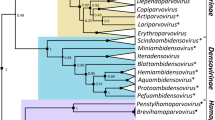Abstract
We report the cloning and analysis of a sample representative of all P-elements from Scaptomyza pallida. We have compared four independent stocks of this species, using Southern blot and in situ hybridization experiments to examine the number, structure, and distribution of P-elements. All four stocks give similar results: they contain about 15 P-elements including three to four full-length elements as well as shorter, deleted elements. All elements are divergent from one another and most of them appear to be immobile since they are located at identical positions in the genomes of independent stocks. These data indicate that P-elements are old components of the S. pallida genome. Moreover, the presence of P-sequences in species closely related to S. pallida suggests that they have had a long evolutionary history in the Scaptomyza genus. We have also found that most P-elements of S. pallida are located in the pericentromeric heterochromatin. This corroborates other studies which show that in the course of their evolution, transposable elements tend to accumulate into pericentromeric heterochromatin, where they become immobile and noncoding.
Similar content being viewed by others
References
Anxolabéhère D, Kidwell MG, Periquet G (1988) Molecular characteristics of diverse populations are consistent with the hypothesis of a recent invasion of Drosophila melanogaster by mobile P elements. Mol Biol Evol 5:252–269
Anxolabéhère D, Nouaud D, Périquet G (1985) Séquences homologues à l'élément P chez des espèces de Drosophila du groupe obscura et chez Scaptomyza pallida (Drosophilidae). Genet Sel Evol 17:579–584
Anxolabéhère D, Nouaud D, Périquet G (1987) Evolutionary genetics of the P transposable elements in Drosophila melanogaster and in the Drosophilidae family. Life Sci Adv Ser C 1:37–46
Brookfield JFY, Montgomery E, Langley CH (1984) Apparent absence of transposable elements related to the P elements of D. melanogaster in other species of Drosophila. Nature 310:330–332
Crozatier M, Vaury C, Busseau I, Pélisson A, Bucheton A (1988) Structure and genomic organization of I elements involved in IR hybrid dysgenesis in Drosophila melanogaster. Nucleic Acids Res 16:9199–9213
Daniels SB, Peterson KR, Strausbaugh LD, Kidwell MG, Chovnick A (1990) Evidence for horizontal transmission of the P transposable element between Drosophila species. Genetics 124:339–355
Daniels SB, Strausbaugh LD (1986) The distribution of P-element sequences in Drosophila: the willistoni and saltans species groups. J Mol Evol 23:138–148
Daniels SB, Strausbaugh LD, Ehrman L, Armstrong R (1984) Sequences homologous to P elements occur in Drosophila paulistorum. Proc Natl Acad Sci USA 81:6794–6797
Engels WR (1989) P elements in Drosophila melanogaster. In: Berg DE, Howe MM (eds) Mobile DNA. American Society for Microbiology, Washington, DC, pp 437–484
Hagemann S, Miller WJ, Pinsker W (1992) Identification of a complete P-element in the genome of Drosophila bifasciata. Nucleic Acids Res 20:409–413
Junakovic N, Caneva R, Ballario P (1984) Genomic distribution of copia-like element in laboratory stocks of Drosophila melanogaster. Chromosoma 90:378–382
Karess RE, Rubin GM (1984) Analysis of P transposable element functions in Drosophila. Cell 38:135–146
Kidwell MG, Kidwell JF, Sved JA (1977) Hybrid dysgenesis in Drosophila melanogaster: A syndrome of aberrant traits including mutation, sterility, and male recombination. Genetics 86:813–833
Lansman RA, Shade RO, Grigliatti TA, Brock HW (1987) Evolution of P transposable elements: Sequences of Drosophila nebulosa P elements. Proc Natl Acad Sci USA 84:6491–6495
Lansman RA, Stacey SN, Grigliatti TA, Brock HW (1985) Sequences homologous to the P mobile element of Drosophila melanogaster are widely distributed in the subgenus Sophophora. Nature 318:561–563
Laski FA, Rio DC, Rubin GM (1986) Tissue specificity of Drosophila P element transposition is regulated at the level of mRNA splicing. Cell 44:7–19
Miklos GLG, Yamamoto MT, Davies J, Pirrotta V (1988) Microcloning reveals a high frequency of repetitive sequences characteristic of chromosome 4 and the β-heterochromatin of Drosophila melanogaster. Proc Natl Acad Sci USA 85:2051–2055
Miller WJ, Hagemann S, Reiter E, Pinsker W (1992) P-element homologous sequences are tandemly repeated in the genome of Drosophila guanche. Proc Natl Acad Sci USA 89:4018–4022
Montgomery E, Charlesworth B, Langley CH (1987) A test for the role of natural selection in the stabilization of transposable element copy number in a population of Drosophila melanogaster. Genet Res 49:31–41
Mullins MC, Rio DC, Rubin GM (1989) Cis-acting DNA sequence requirements for P element transposition. Genes Dev 3:729–738
O'Hare K, Rubin GM (1983) Structure of P transposable elements and their sites of insertion and excision in the Drosophila melanogaster genome. Cell 34:25–35
Paricio N, Pérez-Alonso M, Martinez-Sebastian MJ, De Frutos R (1992) P-sequences of Drosophila subobscura lack exon 3 and may encode a 66 kd repressor-like protein. Nucleic Acids Res 19:6713–6718
Rio DC, LaskiFA, Rubin GM (1986) Identification and immunochemical analysis of biologically active Drosophila P element transposase. Cell 44:21–32
Robertson HM, Engels WR (1989) Modified P elements that mimic the P cytotype in Drosophila melanogaster. Genetics 123:815–824
Ronsseray S, Lehmann M, Anxolabéhère D (1991) The maternally inherited regulation of P elements in Drosophila melanogaster can be elicited by two P copies at cytological site 1A on the X chromosome. Genetics 129:501–512
Simonelig M, Anxolabéhère D (1991) A P element of Scaptomyza pallida is active in Drosophila melanogaster. Proc Natl Acad Sci USA 88:6102–6106
Simonelig M, Bazin C, Pélisson A, Bucheton A (1988) Transposable and nontransposable elements similar to the I factor involved in I-R hybrid dysgenesis in Drosophila melanogaster coexist in various Drosophila species. Proc Natl Acad Sci USA 85:1141–1145
Stacey SN, Lansman RA, Brock HV, Grigliatti TA (1986) Distribution and conservation of mobile elements in the genus Drosophila. Mol Biol Evol 3:522–534
Throckmorton LH (1975) The phylogeny, ecology and geography of Drosophila. In: King RC (ed) Handbook of genetics, 3. Plenum, New York, pp 421–469
Vaury C, Bucheton A, Pelisson A (1989) The β heterochromatic sequences flanking the I elements are themselves defective transposable elements. Chromosoma 98:215–224
Author information
Authors and Affiliations
Additional information
Correspondence to: M. Simonelig
Rights and permissions
About this article
Cite this article
Simonelig, M., Anxolabéhère, D. P-elements are old components of the Scaptomyza pallida genome. J Mol Evol 38, 232–240 (1994). https://doi.org/10.1007/BF00176085
Received:
Accepted:
Issue Date:
DOI: https://doi.org/10.1007/BF00176085




